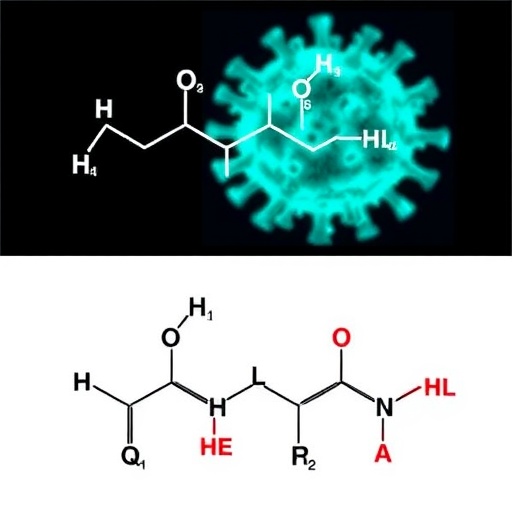Recent advancements in the fight against the COVID-19 pandemic have led to the exploration of various compounds with the potential to inhibit the virus’s replication mechanisms. A significant contribution to this area of research has come from a team led by Das et al., who have synthesized a series of 9-fluorenone-based sulfonamide derivatives. These compounds exhibit promising dual inhibition activity against the SARS-CoV-2 Main Protease (Mpro) and Papain-like Protease (PLpro), two essential enzymes that facilitate viral replication and pathogenesis.
The significance of inhibiting these proteases lies in their critical roles in the SARS-CoV-2 life cycle. Mpro is responsible for processing the viral polyproteins into functional proteins necessary for viral replication. Meanwhile, PLpro plays a crucial role in the viral life cycle by removing ubiquitin and ISG15 from host proteins, allowing the virus to evade the host’s immune response. Consequently, the development of inhibitors that can target these proteases is of paramount importance for antiviral drug development.
The research team identified a series of synthetic sulfonamide compounds based on the 9-fluorenone scaffold. This structural framework is known for its biological activity and stability, making it an attractive candidate for further modifications. The synthetic process involved multiple steps, including the formation of sulfonamide linkages, which are crucial for enhancing the interaction of these compounds with the target proteases. The team meticulously optimized various parameters to ensure high yields and purity of the final products.
To evaluate the efficacy of these synthesized compounds, the researchers carried out a series of in vitro assays. These tests demonstrated that select 9-fluorenone-based sulfonamides exhibited potent inhibitory effects against both Mpro and PLpro. The observed IC50 values, which indicate the concentration required to inhibit 50% of the enzyme activity, were significantly low, suggesting that these compounds could be highly effective as therapeutic agents. The dual inhibition profile also enhances their appeal, as targeting both proteases simultaneously could prevent viral adaptation and resistance.
In addition to enzyme activity assays, the researchers employed molecular docking studies to gain insights into the interactions between the sulfonamide compounds and the target proteases. These computational studies provided a detailed understanding of the binding affinities and molecular interactions, revealing that the sulfonamides engage in crucial hydrogen bonding and hydrophobic interactions with the active sites of both Mpro and PLpro. This mechanistic understanding is critical as it informs the design of more potent derivatives and helps predict potential side effects.
Despite the promising results, the authors acknowledge that further testing is necessary to assess the therapeutic potential of these compounds in vivo. Animal models, as well as eventual clinical trials, will be essential in determining the safety, pharmacokinetics, and efficacy of the lead compounds in a biological context. The researchers are optimistic that, with additional investigation, these 9-fluorenone sulfonamides could soon be translated into effective antiviral therapies that complement existing treatment strategies for COVID-19.
Moreover, this study contributes to the larger body of research seeking to identify novel inhibitors of SARS-CoV-2. As the virus continues to evolve, the emergence of new variants necessitates a constant pipeline of innovative drug candidates. The ability of these sulfonamide compounds to target critical viral proteases places them within a vital category of therapeutic agents that could help mitigate the impact of current and future outbreaks.
In the context of global health, the findings from Das et al. highlight the importance of interdisciplinary collaboration in addressing complex challenges such as COVID-19. The fusion of synthetic chemistry, molecular biology, and computational drug design has propelled this work forward, showcasing the power of modern scientific approaches in combating viral diseases.
To further this research, the team plans to explore structure-activity relationships (SAR) to systematically evaluate how modifications to the chemical structure influence biological activity. This iterative process of chemical synthesis and biological testing is essential for refining their compounds towards higher potency and selectivity.
In conclusion, the innovative work by Das and colleagues presents a noteworthy step in developing dual inhibitors targeting SARS-CoV-2 proteases. The dual-action strategy, paired with the promising results from both experimental and computational studies, lays a strong foundation for future explorations in antiviral drug discovery. As the scientific community mobilizes to respond to the ongoing pandemic, research like this underscores the continuous need for novel therapeutic interventions against SARS-CoV-2.
With an ongoing focus on broadening the therapeutic arsenal for COVID-19, the discovery of 9-fluorenone-based sulfonamide compounds not only exemplifies a significant scientific achievement but also raises hopes for more effective treatment options in the imminent future. The collaborative efforts within the research community, along with governmental and institutional support, are critical to bringing these groundbreaking findings from the laboratory to the clinic.
Ultimately, the path from discovery to application is fraught with challenges, yet the continued dedication of scientists like Das et al. points towards a brighter horizon in the battle against viral pandemics. The potential translation of these novel compounds into clinically relevant therapies could play a crucial role in managing public health crises and enhancing global preparedness for future viral threats.
As we anticipate further developments in this arena, it is essential to continue supporting research initiatives that aim to elucidate and exploit the vulnerabilities of pathogenic viruses such as SARS-CoV-2. This research stands as a beacon of hope, guiding the way toward novel antiviral approaches that will ultimately benefit global health.
Subject of Research: Dual inhibitors of SARS-CoV-2 Main Protease and Papain-like Protease
Article Title: 9-fluorenone-based synthetic sulfonamide compounds as dual inhibitors of SARS-CoV-2 Main-Protease and Papain-like Protease
Article References:
Das, S., Sunnapu, P., Rafi, M. et al. 9-fluorenone-based synthetic sulfonamide compounds as dual inhibitors of SARS-CoV-2 Main-Protease and Papain-like Protease.
Mol Divers (2025). https://doi.org/10.1007/s11030-025-11315-2
Image Credits: AI Generated
DOI: 10.1007/s11030-025-11315-2
Keywords: SARS-CoV-2, Protease inhibitors, Sulfonamides, Antiviral research, COVID-19, Therapeutic strategies, Molecular docking, Structural biology, Drug discovery




